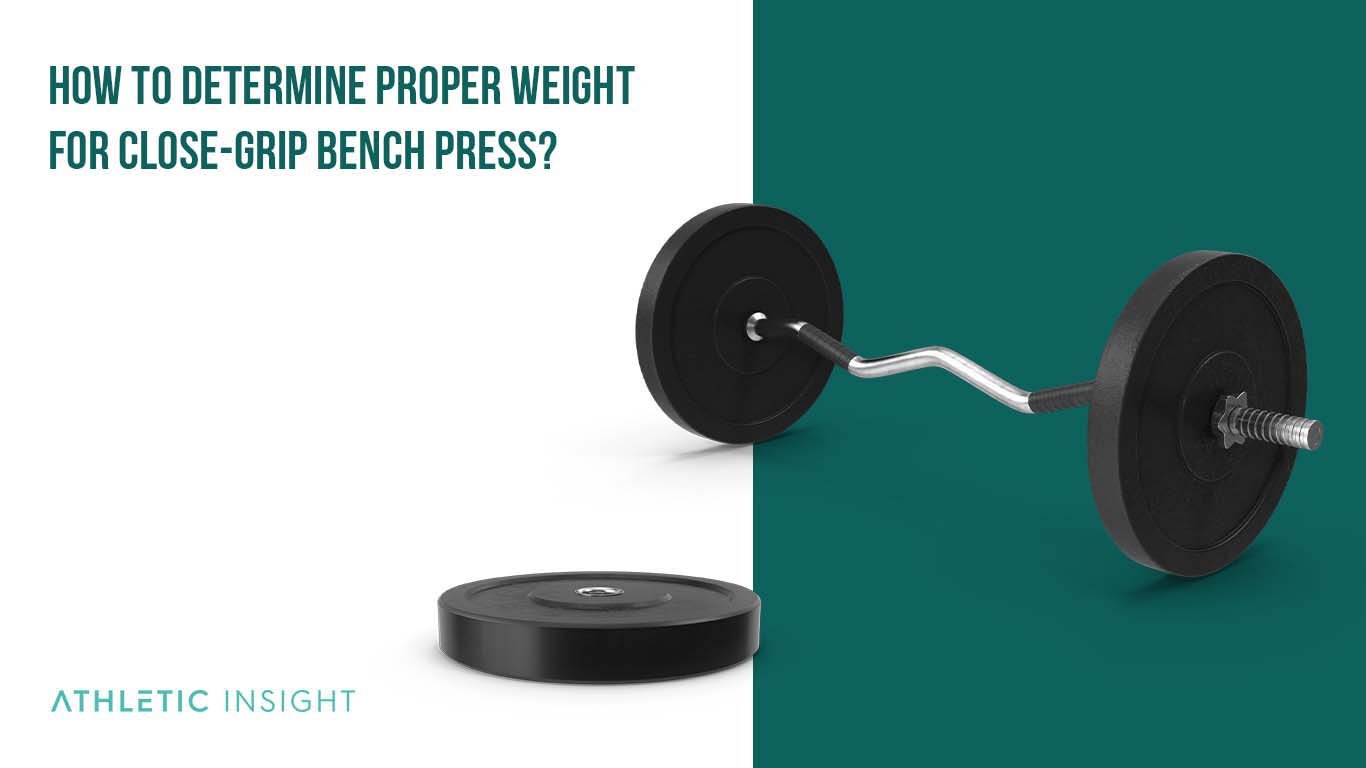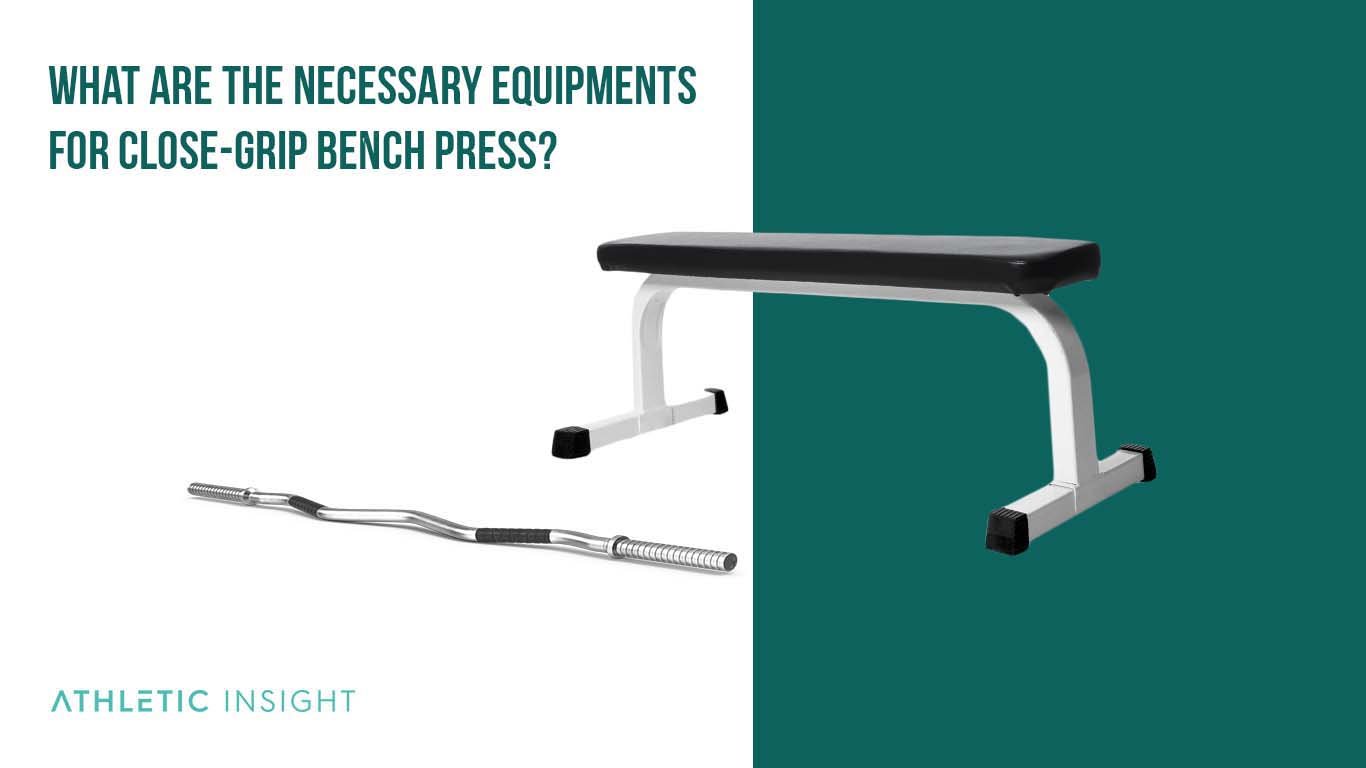A close-grip bench press is a compound exercise and a variation of the traditional bench press. It involves lying on your back and lifting a barbell from your chest. When performing a close-grip bench press, the hands are closer together than when doing a traditional or “wide-grip” bench press.
The close-grip bench press has several benefits. For example, it does a better job of working out and building your triceps than a wide-grip press. Furthermore, it puts less strain on your shoulders, making it ideal for those with shoulder pain or injuries.
As mentioned, the close-grip press puts on an emphasis on your triceps, but it still works out your chest. Specifically, the main muscles you’ll target are the triceps, anterior deltoid (the front of your shoulder), and the pectoralis major (your upper chest).
Good grip strength is necessary to perform the close-grip bench press properly, as you can’t rely on your shoulder strength as much. Furthermore, you need to maintain proper form. It’s a good idea to use a spotter until you master the correct close-grip bench press form, or it can result in injuries.
To perform the close-grip bench press, take the barbell from the rack and lift it, keeping your hands around shoulder-width apart or a bit closer than that. Exhale as you slowly bring it down to your chest, keeping your elbows parallel. Exhale as you push up forcefully, and repeat.
To maintain proper form, you’ll want to keep your hands not closer than six inches apart from each other. The elbows should be close to your sides and your arms shoulder-width from each other. Keep your back straight and lift smoothly, avoiding sudden movements.
There are three main types of close-grip bench press exercises. They include the standard close-grip barbell bench press, the close-grip dumbbell bench press, and the close-grip floor press.
Top close-grip bench press mistakes include holding the hands too close together, flaring the elbows out too far, tucking the elbows too close together, and positioning the barbell too high up on your chest.
Other common mistakes include not using a spotter or using too much weight. Most people should start with around 80% of the weight they typically use when bench-pressing. As your triceps are more involved and your shoulders less so, you may not be able to handle the same weight as you can when performing a wide-grip press.
Common injuries include elbow pain and inflammation. Tricep injuries are common as well. While a close-grip press puts less strain on your shoulders, it’s still possible to injure them. Using proper close-grip bench press techniques, like a slow and steady descent, can help prevent injuries.
Proper form is critical for preventing injuries, particularly elbow flare-ups. Tucking your elbows in too much or flaring them out can put too much pressure on your elbows, shoulders, or joints. Strengthening your triceps by performing other exercises, such as dips, can help prevent tricep injuries when performing the close-grip barbell press.
How to Perform Close-Grip Bench Press With Proper Form?
Start by lying on the bench, with your back straight (not arched) and your legs firmly placed on the ground. Hold the barbell while it’s still on the rack, keeping your arms shoulder-width apart. Brace your shoulder blades and keep your arms straight. Then, follow these steps.
- From the starting position (defined above), take the barbell from the rack and lift it over your head.
- Bring it down slowly and steadily. Don’t let it drop. It should touch your chest at a point that is a bit lower than what you are used to when performing a regular wide-grip press. Inhale as you let it down.
- Pause at the bottom.
- Exhale and push the bar up. Keep your elbows tucked in. Don’t let them flare out. Focus on keeping them parallel to each other. Keep your arms locked at the top.
- Repeat the exercise until you finish the set. Focus on maintaining proper form.
- When you finish your set, slowly put the barbell back on the rack.
Proper form is critical for this tricep exercise. Otherwise, you’ll put unwanted stress on your triceps, elbows, and joints. If done correctly, close-grip bench press is an effective workout to include in your tricep exercise routine.
Furthermore, proper form will ensure you get the most out of the close-grip bench press, building up your triceps, which may be underdeveloped compared to your shoulders. While the close-grip bench muscles worked include the shoulders, the exercise puts more strain on your triceps than the wide-grip press.
What Are the Benefits of Close-Grip Bench Press?
Most lifters only perform the wide-grip bench press, failing to incorporate the close-grip press into their workout routines. That’s because they don’t understand the benefits of this crucial exercise. Here are the top reasons to perform the close-grip bench press.
- Gives you strong triceps: Strong triceps are critical for many exercises. Furthermore, strong triceps are crucial if you want big arms. In a wide-grip bench press, the triceps only account for 22% of the strength needed to lift the barbell, compared to 37% in a close-grip press.
- Improves your bench press lockout: Many professional lifters struggle on the lockout – the last portion of the ascending lift. One reason for getting stuck on the lockout is having weak and underdeveloped triceps.
- Close-grip bench press lessens elbow flaring: If your elbows flare out when performing the bench press, try switching to the close-grip press, which keeps your arms closer together.
- Diminishes stress on shoulders: If you have shoulder pain, you don’t have to give up on the bench press altogether. Switching to a close-grip press allows you to continue pressing while putting less strain on your shoulders.
- Increases your upper chest activation: Instead of incorporating additional exercises (often involving cables) to work out the upper chest, try using a close grip for some of your bench press sets, as it will put more emphasis on the upper chest.
- Improves the upper chest aesthetic: If your upper chest looks less developed than your lower chest, using a close grip can help. Does a close-grip bench work the chest? It sure does, including parts that are frequently ignored.
- Close-grip bench press improves the aesthetic of the inner chest: Similarly, you’ll be working out the inner chest muscles more than with a wide-grip press, as your arms will be closer together.
- Consumes less time for performing: The close-grip press is great for speed and velocity, allowing you to finish your workout quicker.
What Are the Mistakes for Close-Grip Bench Press?
The most common mistakes for the close-grip press involve improper close-grip bench press form. Here are some of the most common mistakes you’ll see.
- One of the most common errors is to use a grip that is too close. Many lifters hear the name “close-grip press” and think the hands must be touching each other. That can cause the shoulders to internally rotate and strain the joints, leading to injuries. Instead, a good close-grip bench press form involves keeping the hands directly above the shoulders.
- Another common mistake is flaring the elbows out too much or tucking them too close together.
- Arching your back instead of keeping it flat on the bench is another common mistake.
- Holding the barbell too close to your chin or not maintaining a straight path of ascent and descent are common errors.
How to Determine Proper Weight for Close-Grip Bench Press?
Your triceps might not be as powerful as you think. When performing a narrow chest press, start with 75-80% of the weight you use when performing a wide-grip press. If it’s easy, add more weight; if you find the exercise difficult, take off some weight.

For example, if you normally lift 100lbs (50lbs on each side), start with 35-40lbs on each side. Add or subtract 5lbs from each side until you arrive at a weight you are comfortable with. You should be able to maintain proper form throughout the lift – that’s more important than the amount of weight you’re lifting.
Which Muscles Are Involved While Performing Close-Grip Bench Press?
These muscles are involved when performing a close-grip BB bench press.
- The anterior deltoid muscles: While not as involved as in a regular press, you need your shoulders to lift the barbell. Since your arms are closer together, the front part of your shoulder is more involved.
- The chest: The pectoralis major and inner chest muscles are necessary to lift the barbell.
- The triceps: You’ll feel an extra strain on your triceps while performing the close-grip BB bench press, specifically the lateral head, which may be lagging in development.
What Are the Close-Grip Bench Press Variations?
The close-grip bench press for chest variations works out the same muscles as the close-grip bench press but may involve different equipment, movements, and body positions. You may need to perform a variation of the close-grip bench press if you don’t have or don’t want to use a barbell or bench.

- Close-grip dumbbell press: The close-grip dumbbell press variation uses dumbbells instead of a barbell. It’s perfect if you don’t have a spotter and are worried about the barbell getting stuck on your chest.
- Close-grip floor press: The floor press involves lifting from the floor instead of a bench. It’s useful if you don’t have a bench.
- Close-grip push-up: If you don’t have any equipment at all, or if you like performing push-ups, putting your arms closer together can work out your triceps more.
What Are the Necessary Pieces of Equipment for Close-Grip Bench Press?
To perform a CGBP exercise, you’ll need the following equipment.

- A bench: You’ll need a bench, ideally one with a rack.
- A barbell: If you don’t have a barbell, you can use dumbbells.
- Plates: Plates of varying weights allow you to increase resistance over time.
- Placeholders for the plates: These are optional but ensure the plates won’t fall off the barbell.
What Is the Origin of Close-Grip Bench Press?
The bench press became popular in the 1950s. As time went by, lifters and bodybuilders started experimenting with different variations to target different muscle groups. They discovered that holding the arms closer together (as with a narrow-grip chest press) puts less strain on the shoulders.
Who Named the Close-Grip Bench Press?
It is not exactly clear who named the close-grip bench press. It became more popular recently as fitness YouTubers started recommending it. However, it was always a common exercise among lifters.
Which Muscles Can Be Affected More From Close-Grip Bench Press?
The close grip bench press can affect these muscles.
- The tricep
- The anterior deltoid
- The pectoralis major
The muscle groups most affected are the triceps and anterior deltoid muscles, simply due to the position of your arms. If you’re wondering what does the close-grip dumbbell press work, the answer is the triceps and anterior deltoid muscles.
What Is the Effectiveness of Close-Grip Bench Press for Muscle Growth When Compared to Squad?
The CGBP lift increases the size of muscle cells through a scientific process known as hypertrophy. By exercising, you are breaking down muscle tissue. When it repairs itself through its natural process, it gets bigger.
What Are the Close-Grip Bench Press Related Facts?
Here are some cool facts about the close-hand bench press.
- Many lifters have never heard of it.
- It allows you to continue bench-pressing after a shoulder injury.
- It can increase testosterone levels.
- It is a compound movement.
- It is a safe exercise.
Many lifters never hear about the close-hand bench press until they suffer a shoulder injury. By performing it now, you can avoid that injury altogether.
Does Close-Grip Bench Press Affect the Hormones?
Yes. Weight training exercises, including the closed-grip bench press, can elevate levels of testosterone and growth hormone. These hormones help repair your muscles and make them bigger, and they also help you feel better throughout the day.
Is Close-Grip Bench Press Practiced Within CrossFit?
Yes, the CGBP is sometimes practiced within CrossFit, but it is not a fundamental CrossFit exercise. If your focus is CrossFit, you don’t need to learn how to close grip bench. However, it can help you achieve your goals quicker.
Is Close-Grip Bench Press a Military Movement?
No, the narrow barbell press is not a fundamental military movement. However, many military service members may incorporate it into their regular strength training regimes. It can help them stay strong and fit for service.
Is Close-Grip Bench Press Dangerous?
No, the CGBP is not dangerous. It could be dangerous if you use too much weight or use an improper bench press hand position. That’s why proper form is so important.
Is Close-Grip Bench Press Essential?
No, the CGBP is not an essential exercise. You can perform the wide-grip bench press instead. However, it’s worth incorporating into your workout.
Is Close-Grip Bench Press an Olympic Lift?
No, the close bench press is not typically an Olympic lift. Most Olympic lifters use a standard bench press when competing. However, some may use the CGBP when training.
Is Close-Grip Bench Press a Compound Exercise?
Yes. The barbell or dumbbell close grip press are compound exercises. Compound movements are those that work out several major muscles (like the shoulders and chest) at once instead of focusing on a single muscle (like the bicep).
What Can Replace Close-Grip Bench Press?
The close-grip push-up can replace the close grip bench grip. Similarly, the close-grip dumbbell press can replace the close-grip barbell press. A combination of non-compound movements, like tricep pullbacks and front arm raises, can also replace this exercise.



